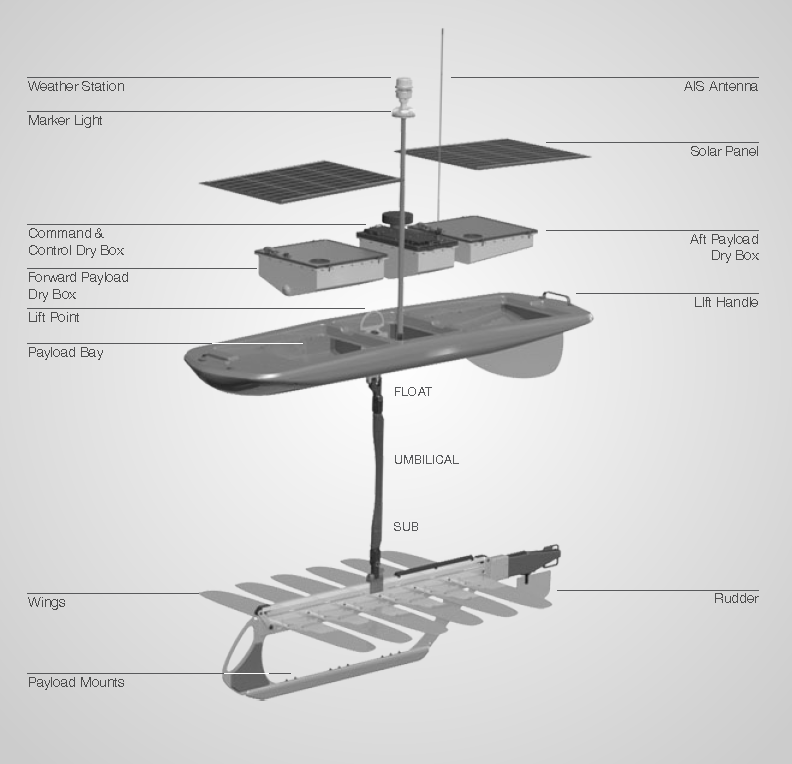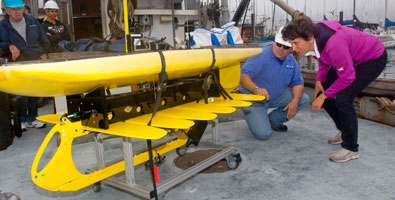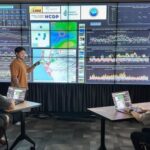Stanford University’s Professor of Marine Sciences, Barbara Block, wants to preserve the ocean ecosystem by using smart buoys. The project is called the “wired ocean.” The buoys would be part of a network of ocean listening stations. The plan is to detect sea life from large ocean going predators like Great White Sharks so that the public can be aware of their locations at all times. Such long-term monitoring of sea life will give us a stronger understanding of the ecology of the ocean.
Global ocean monitoring has been a subject we have covered before on this blog. The Argo Programme has deployed 3,500 floating sensors that constantly meter the ocean’s temperature and chemistry.
Stanford has recently completed a decade-long project which involved tagging 4,000 large marine animals to find out where they come and go seasonally. The marine animals were tracked by satellite. The data collected identified hot spots in the ocean where marine animals tended to congregate because of optimal feeding conditions.
Wave Glider and the Wired Ocean
Satellite sensor equipment is expensive. That’s why Stanford has turned to using a technology from Liquid Robotics, a Sunnyvale, California company, the developer of the Wave Glider. This unique and inexpensive marine robot operates autonomously using its on board computer, GPS, a weather station, solar panels, and an umbilical attached to a sub-surface mechanical propulsion system designed to convert wave action into forward thrust (see picture below). A Wave Glider can pick up the acoustic signal from any tagged animal that passes within 300 meters (approximately 1,000 feet) and transmit the data to a research team on shore.

Wave Gliders have been in operation since 2008 logging as many as 400 days at sea before returning to their home ports. Total distance traveled has exceeded 160,000 kilometers (100,000 miles). One recently took a trip from Monterey Bay to the Alaska coast enduring Sea State 6 conditions with 6 meter (20-foot) waves and 74 kilometer (40-knot) winds. Having been on a cruise ship off the Alaska coast in 6-meter seas I can tell you my stomach and head didn’t survive the experience very well. So I consider Wave Glider’s abilities to be pretty impressive.
Global Ocean Monitoring the Ultimate Goal
For the moment the work at Stanford is focused on wildlife off the California coast and in particular near Monterey Bay. The university hopes to monitor sharks, sea turtles and other large species to build an information database that it can share with the public to give all of us a better picture of the ocean off the California coast.
But what Stanford is doing locally off California has global implications. Technology such as the Wave Glider will help us better understand the health of the largest creatures in our oceans. We should be able to identify areas within the ocean where we can establish marine preserves to ensure survival of species like the Great White, Salmon and Mako Shark, as well as marine mammals and reptiles. It is hoped through such efforts that global public awareness will lead to preservation and conservancy.










I would add mobile drones/USV types, seafloor sensors tied to anchored buoys, sensors on cruise and cargo ships, creating a worldwide mesh network of ocean data.
Hi Stephen, I edited your reply and hope I did it justice.
I was unaware of the highly ingenious Wave Glider until I saw it on your blog. I wonder what it costs. Sounds like it would lend itself well to widespread real time monitoring of phytoplankton population.
Best I can understand, the anthropic CO2 component of the atmosphere accounts for most of the increase over the last century. But it’s not nearly as simple as burning fossil fuel causing global warming. The oceans are playing a major role. A couple of years back “Nature” published an alarming article asserting that a recent Secchi disk study of the world’s oceans shows that phytoplankton has declined some 40% over the last century, and continues to decline at about 1% per year. That’s staggering. The basic principle of the Secchi disk lowered on a rope is standard optical measurement of surface water turbidity. The more phytoplankton, the more turbid the water.
Surface waters are generally defined as the waters penetrated and influenced by solar radiation. Should be obvious that clearer waters allow the suns rays to penetrate deeper than they would in turbid waters. But guess what, it takes longer for infrared radiation and conduction to transport heat out of deep water than from shallow water. The huge decline of phytoplankton means the solar energy absorbed by surface waters penetrates deeper and takes longer to radiate out from the surface at night. Phytoplankton has historically provided “shade” for deeper water, and its loss is responsible for some significant portion of rising ocean surface temperatures. The warmer surface waters can hold less CO2 in solution, and the smaller amount of phytoplankton is removing less CO2 through photosynthesis. A significant, but not well quantified, percentage of carbon incorporated into phytoplankton structure eventually winds up permanently sequestered in the abysmal depths. That process is now sequestering 40% less carbon than it did a century ago.
What we urgently need to discover now is what is causing the phytoplankton decline. The naïve answer is that the warmer temperatures and higher CO2 levels are causing the phytoplankton decline, but all the physics I can understand is suggesting the exact opposite. The phytoplankton decline is causing the warmer temperatures and higher CO2 levels. Since the Nature article was first published, I have seen no report of anything plausible that might account for the decline. The scale of the plankton decline dwarfs the burning of fossil fuels. I haven’t seen any treatment of oceanic heat fluxes as they relate to phytoplankton populations either. I’m a lot more concerned about the ocean’s tiny phytoplankton than I am about great white sharks. I’m guessing it will prove impossible to stabilize atmospheric carbon and global climate without first stabilizing and restoring the phytoplankton population.
Acidification, fertilizer runoff, algal blooms and die offs are contributing to a decline in phytoplankton populations. I will look through my research notes to see if I can find you some source journal references if you like.
I’d very much like to see a report that is not basically conjecture. A report that experimentally links small changes in ocean pH to massive global plankton decline is the one I want to see. My engine of conjecture probably makes as many RPMs as the next man’s, and probably more than most. The following excerpt from a NOAA report on acidification is representative of sort of thing I see: “Low pH may be a factor in the current oyster reproductive failure; however, more research is needed to disentangle potential acidification effects from other risk factors, such as episodic freshwater inflow, pathogen increases, or low dissolved oxygen. It is premature to conclude that acidification is responsible for the recent oyster failures, but acidification is a potential factor in the current crisis to this $100 million a year industry, prompting new collaborations and accelerated research on ocean acidification and potential biological impacts.”
See: http://www.pmel.noaa.gov/co2/story/What+is+Ocean+Acidification%3F
Notice the report doesn’t mention the facts that atmospheric CO2 and ocean pH is the same along the Texas and Louisiana Gulf Coasts where the unpolluted oyster harvesters are doing just fine. It’s all self-serving conjecture. Only empirical experiments with controls can settle the questions. NOAA is saying, “This possibility could be important; give us more money and we will study it some more.” But I suspect no matter how much money we give to NOAA it will never provide answers that would satisfy a numerate critical mind, and which reduce the need for further study.